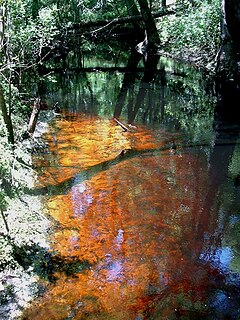Blackwater river
A blackwater river is a river with a deep, slow-moving channel flowing through forested swamps or wetlands. Its colour is caused by the decaying vegetation. As vegetation decays, tannins leach into the water, making a transparent, acidic water that is darkly stained, looking like tea or coffee.


Most rivers in the Amazon Basin and the Southern United States are blackwater rivers. Not all dark rivers are blackwater in that technical sense. Some rivers in temperate regions, which drain or flow through areas of dark black soil, are black due to the color of the soil. These rivers are black mud rivers or estuaries.
Blackwater rivers are lower in nutrients than whitewater rivers and have ionic concentrations higher than rainwater.[1][2] The unique conditions lead to flora and fauna that differ both from whitewater and clearwater rivers.[3][4]
The classification of Amazonian rivers into black, clear and whitewater was first proposed by Alfred Russel Wallace in 1853.[3]
References
change- ↑ Janzen, D.H. (July 1974). "Tropical blackwater rivers, animals, and mast fruiting by the Dipterocarpaceae". Biotropica. 6 (2): 69–103. doi:10.2307/2989823. JSTOR 2989823.
- ↑ Sioli, Harald (1975). "Tropical rivers as expressions of their terrestrial environments". Tropical Ecological Systems/Trends in Terrestrial and Aquatic Research. New York City: Springer Springer-Verlag: 275–288.
- ↑ 3.0 3.1 Duncan W.P. & Fernandes M.N. 2010. Physicochemical characterization of the white, black, and clearwater rivers of the Amazon Basin and its implications on the distribution of freshwater stingrays (Chondrichthyes, Potamotrygonidae). PanamJAS 5(3): 454-464.
- ↑ Wallace, Alfred Russel 1853. On the Rio Negro. Journal of the Royal Geographical Society 23: 212-217.